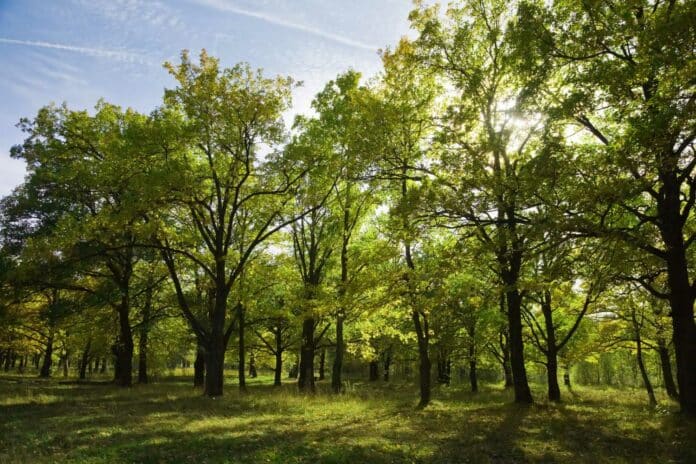Photorespiration is a process in plants that occurs during photosynthesis, where they consume oxygen (O2) and release carbon dioxide (CO2) instead of the usual reverse process. The extent and variation of photorespiration in today’s environment are not fully understood.
The ability of trees to effectively absorb and store carbon dioxide (CO2), a crucial mechanism for offsetting human carbon emissions, is being hindered in warmer and drier climates, according to a recent study led by researchers from Penn State.
Max Lloyd, assistant professor of geosciences at Penn State, said, “We found that trees in warmer, drier climates are essentially coughing instead of breathing. They send CO2 back into the atmosphere far more than trees in cooler, wetter conditions.”
Photosynthesis enables trees to extract carbon dioxide (CO2) from the atmosphere, contributing to new growth. However, under stressful conditions, trees undergo photorespiration, releasing CO2 back into the atmosphere. A global analysis of tree tissue by the research team revealed that the rate of photorespiration increases up to two times in warmer climates, mainly when water is scarce. The threshold for this response in subtropical climates begins to be crossed at average daytime temperatures exceeding approximately 68 degrees Fahrenheit and intensifies with further temperature increases.
These findings challenge the widespread belief about the role of plants in carbon sequestration and provide new insights into how plants might adapt to climate change. Crucially, as the climate warms, the study suggests that plants may become less efficient at removing CO2 from the atmosphere and assimilating the necessary carbon, potentially hindering their role in cooling the planet.
Lloyd said, “We have knocked this essential cycle off balance. Plants and climate are inextricably linked. The biggest draw down of CO2 from our atmosphere is photosynthesizing organisms. It’s a big knob on the composition of the atmosphere, so that means small changes have a large impact.”
Currently, plants absorb approximately 25% of the CO2 emitted by human activities annually, as per the U.S. Department of Energy. However, this percentage is likely to decline in the future as the climate warms, especially in scenarios where water becomes scarcer, according to the study led by Lloyd. The warming climate poses a tradeoff because although increasing CO2 levels theoretically benefits plants, the rise in temperatures may hinder their ability to draw down CO2 effectively.
In the research, the scientists identified that the abundance variation of specific isotopes in a component of wood called methoxyl groups serves as a tracer for photorespiration in trees. Isotopes are analogous to different flavors of atoms. By studying the methoxyl “flavor” of isotopes in wood samples from various trees worldwide, the researchers observed trends in photorespiration. The samples were obtained from a collection at the University of California, Berkeley, containing wood samples dating back to the 1930s and 40s, providing valuable historical data for the study.
Lloyd said, “The database was originally used to train foresters how to identify trees from different places around the world, so we repurposed it to reconstruct these forests to see how well they were taking in CO2.”
Traditionally, measuring photorespiration rates required real-time assessments on living plants or well-preserved dead specimens that retained structural carbohydrates. This limitation made it nearly impossible to study the rate at which plants sequester carbon on a large scale or examine historical photorespiration rates.
However, the newly validated method of observing photorespiration rates using wood provides a tool for researchers to predict how efficiently trees might absorb carbon in the future and how they performed in past climates.
With carbon dioxide levels in the atmosphere rapidly increasing to levels unprecedented in the last 3.6 million years, according to the National Oceanic and Atmospheric Administration, understanding the historical context becomes crucial.
The research team plans to extend their investigations into the ancient past by studying fossilized wood, potentially dating back tens of millions of years. This approach will enable researchers to test existing hypotheses about the changing impact of plant photorespiration on climate over geological time scales.
Journal Reference:
- Max K. Lloyd, Rebekah A. Stein, Daniel E. Ibarra and Daniel A. Stolper. Isotopic clumping in wood as a proxy for photorespiration in trees. Proceedings of the National Academy of Sciences. DOI: 10.1073/pnas.2306736120
